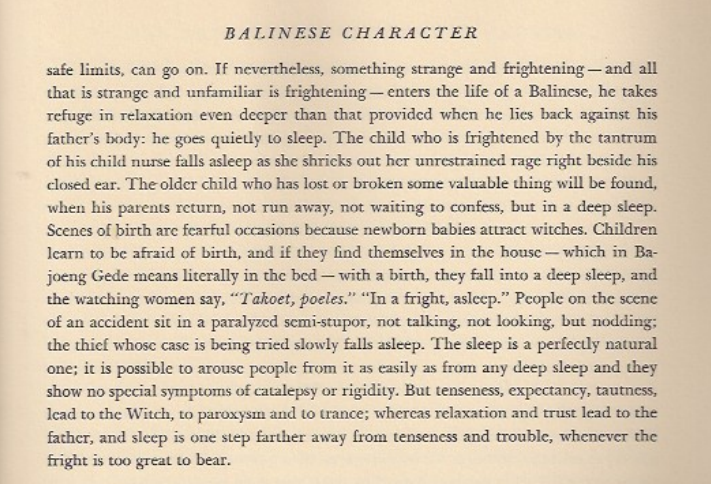When people from the island of Bali in Indonesia are afraid, they fall asleep
A note for Lesson no. 6, "Brains Make More Than One Kind of Mind," in Seven and a Half Lessons About the Brain by Lisa Feldman Barrett.
Some context from page 98 is:
When people from the island of Bali in Indonesia are afraid, they fall asleep. Or at least, that’s what they’re supposed to do.
According to Bateson and Mead, sleeping was a socially approved response to fear; the Balinese called it takoet poeles, which translates to “in a fright sleep.”
The psychologist James Russell notes that the Balinese word tekajut is translated as “an unpleasant and upsetting response to the unexpected.” The unexpected event need not be startling or sudden, but is experienced as obligatory and beyond personal control. In contrast, the Balinese equivalent for the Western stereotype for “fear” is thought to involve personal choice and agency and therefore personal responsibility.[3]
This prescription to fall asleep in fear bears some resemblance to what ethologists call "fear bradycardia" — a situation in which an animal's brain drops its heart rate upon encountering or predicting a threat. In the water (where vertebrates first evolved), touch/vibration is a distance sense, so it's a good idea not to have your heart thumping too forcefully if a hungry shark is nearby that can detect other animals' heartbeats in the water. In humans, this bradycardia may also manifest as fainting in threatening situations.
A snippet from Bateson & Mead's book

References
- ↑ Mesquita, Batja and Nico Fridja. 1992. “Cultural Variations in Emotion: A Review.” Psychological Bulletin 112 (2): 179–204.
- ↑ 2.0 2.1 Bateson, G., and Margaret Mead. 1942. Balinese Character. New York: New York Academy of Sciences.
- ↑ Russell, James A. 1991. “Culture and the Categorization of Emotions.” Psychological Bulletin 110 (3): 426–450.